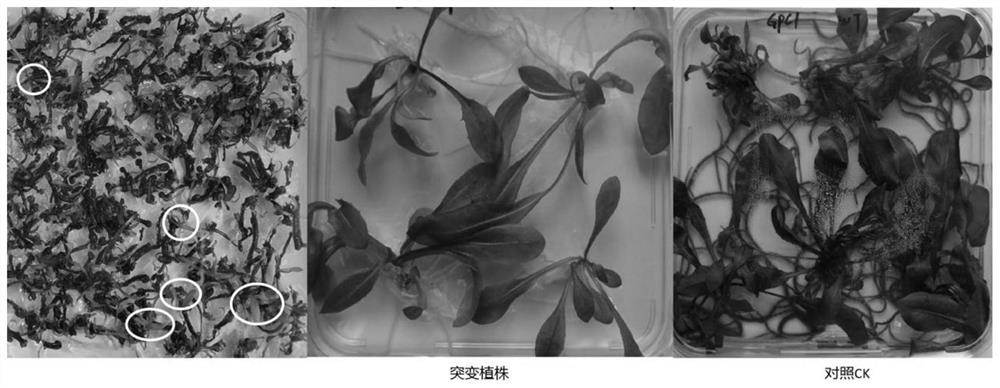Method for site-specific mutagenesis of taraxacum kok-saghyz or dandelion genes by using CRISPR/Cas9 system
A technology of dandelion and rubber grass, which is applied in genetic engineering, plant genetic improvement, chemical instruments and methods, etc., can solve the problems of not yet efficient, and achieve the effect of improving construction efficiency and editing efficiency
- Summary
- Abstract
- Description
- Claims
- Application Information
AI Technical Summary
Problems solved by technology
Method used
Image
Examples
Embodiment 1
[0051] The following examples are used to illustrate the present invention, but are not intended to limit the scope of the present invention. Example 1 Construction of the CRISPR / Cas9 gene editing vector targeting the AtPAP1 gene in transgenic rubber grass overexpressing the AtPAP1 gene
[0052] 1. Design two targeting sgRNA sequences based on CRISPR / Cas9 for the AtPAP1 gene in rubber grass transgenic plants, wherein the nucleotide sequence of target 1 (AtPAP1 / sgRNA1) is 5'-CTTCGCCTTCATAGGCTTCT-3' (SEQ ID NO.3), The nucleotide sequence of target 2 (AtPAP1 / sgRNA2) is 5'-TACGCCCATTCCTACAACAC-3' (SEQ ID NO.4).
[0053] 2. Design and assemble primers according to the targeting sgRNA1 and sgRNA2 sequences of the target gene AtPAP1:
[0054] CmYLCV (SEQ ID NO. 7):
[0055] 5'-TGCTCTTCGCGCTGGCAGACATACTGTCCCAC-3';
[0056] Csy-gRNA1 (SEQ ID NO.8):
[0057] 5′-TCGTCTCC ATGAAGGCGAAG CTGCCTATACGGCAGTGAAC-3';
[0058] rep-gRNA1 (SEQ ID NO.9):
[0059] 5′-TCGTCTCA TCATAGGCTTCT GT...
Embodiment 2
[0069] The preparation method of embodiment 2 gene site-directed mutation rubber grass plant
[0070] 1, the acquisition of rubber grass aseptic seedlings: adopt the rubber grass T2 generation transgenic plant carrying exogenous AtPAP1 gene as acceptor material, concentration is the sodium hypochlorite solution (stock solution presses 100%) of 10-15% (v / v), Add 1 drop (20μL) / 200mL of TritonX-100 and mix to make a disinfectant solution. Use the disinfectant solution to sterilize the T2 generation transgenic seeds for 10-15 minutes, wash them with sterile water for 3-5 times, and then sow them in the seedlings containing 50-100mg / L Germinate in the 1 / 2MS medium of kanamycin, transfer once 5 days later to 1 / 2MS medium containing 50-100mg / L kanamycin and cultivate for about 20 days to obtain sterile seedlings with good root growth. Both root and root are purple.
[0071] 2. Take the roots of sterile seedlings in good growth state, wash them with sterile water for 2-3 times, and d...
Embodiment 3
[0079] Example 3 Detection of gene site-directed mutation rubber grass
[0080] 1. Phenotype observation of AtPAP1 gene site-directed mutation lines
[0081] Observing the adventitious buds induced after the site-directed mutation of the AtPAP1 gene in Example 2, it was found that adventitious buds of green and purple colors were differentiated on the purple root segment, and the purple adventitious buds indicated that the AtPAP1 gene in this part of the root segment The expression is still normal without site-directed mutation, and the green or light-colored adventitious buds indicate that the AtPAP1 gene has been inactivated. The results are shown in figure 1 . From figure 1 It can be seen that the green adventitious buds have no AtPAP1 expression in the circled area, indicating that the AtPAP1 gene has been successfully edited and inactivated in the transformed cells.
[0082] 2. Gene sequencing verification of mutant strains
[0083] (1) DNA extraction: Genomic DNA of ...
PUM
 Login to View More
Login to View More Abstract
Description
Claims
Application Information
 Login to View More
Login to View More - R&D
- Intellectual Property
- Life Sciences
- Materials
- Tech Scout
- Unparalleled Data Quality
- Higher Quality Content
- 60% Fewer Hallucinations
Browse by: Latest US Patents, China's latest patents, Technical Efficacy Thesaurus, Application Domain, Technology Topic, Popular Technical Reports.
© 2025 PatSnap. All rights reserved.Legal|Privacy policy|Modern Slavery Act Transparency Statement|Sitemap|About US| Contact US: help@patsnap.com


